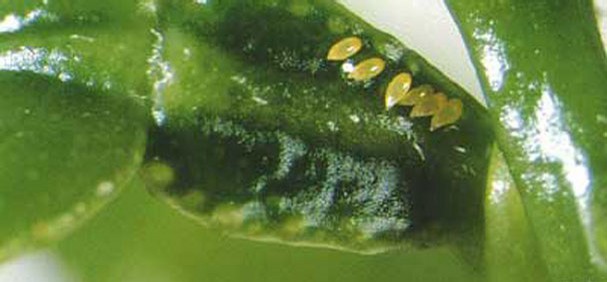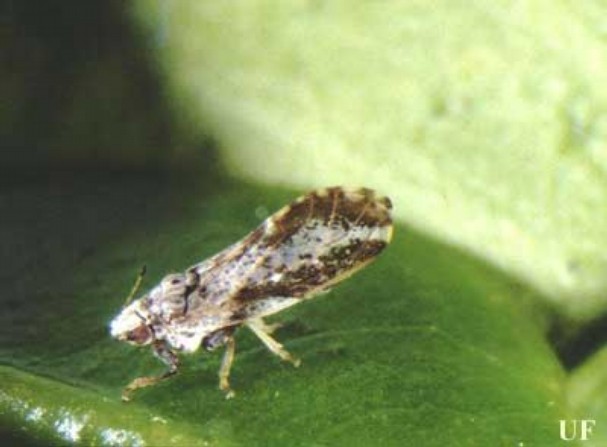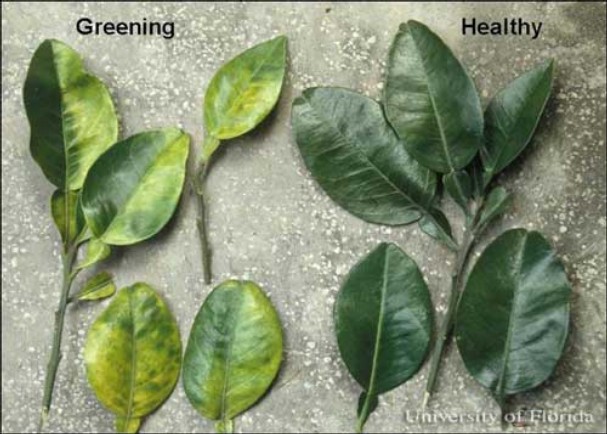http://www.tcpalm.com/news/2009/dec/14/chemical-biological-weapons-used-in-fight-citrus/
Chemical, biological weapons used in fight against citrus greening
* By Paul Ivice
* Posted December 14, 2009 at 7:40 a.m.
Researchers are developing a two-pronged approach to controlling an insect, the Asian citrus psyllid, that spreads the greening disease that currently poses the greatest threat to Floridas citrus industry.
Peter McClure, chairman of the Florida Citrus Products Research Advisory Council, said, Greening is killing trees faster than we can replant and regrow them. Canker doesnt kill your tree.
McClure, who is also agriculture research and business development manager for Vero Beach-based Evans Properties, one of Floridas five largest citrus growers, said greening has killed 10 percent of Evans Properties trees and another 10 percent are infected.
Shawron Weingarten, pest manager for Orange-Co, a large orange grower based in Arcadia, said, The research is very promising, but greening is still spreading and its depressing.
Weingarten said Orange-Co has lost less than 2 percent of its trees to greening, but the disease is still worse than canker because we have more answers for canker.
One problem is that a tree can be infected for up to four years before symptoms appear, Weingarten said.
While more than 100 separate research projects into greening continue, for now psyllids are being attacked with a combination of chemical and biological measures.
After a successful program of aerial spraying last year of more than 100,000 acres of groves, along with ground spraying of most other Gulf Coast groves, researchers confirmed that winter applications are most effective.
Meanwhile, Weingarten and some others are breeding a tiny stingless wasp, Tamarixia radiata, by the millions and plan to release them in the spring when they are most needed.
Spraying before the spring flush of new leaves on trees seems to work best because psyllids are most vulnerable in cooler weather when their population is low and they are not breeding.
If you hit them hard when theyre naturally at their lowest, you get more bang for your buck, said David Hall, research leader of the U.S. Horticultural Research Laboratorys Subtropical Insects Research Unit in Fort Pierce.
Some Treasure Coast groves also were sprayed, but most growers here were more intent of getting their harvest in first, said Doug Bournique, executive vice president of the Indian River Citrus League.
You cant really blame them, Bournique said. We had a very good start to our season when fruit prices were up and people who hadnt had an income for some time wanted to harvest the crop, and you cant spray just before or during the harvest.
Bournique said he expects many more Indian River District growers to participate in a unified spraying project in February.
Phil Stansly, a University of Florida professor of entomology in Immokalee, said the Gulf Coast spraying made an enormous difference. The few groves there that were not sprayed had psyllid populations as much as 30 times greater, Stansly said.
Furthermore, winter spraying does the least damage to one of the psyllids natural predators, lady beetles.
At least four lady beetle species in Florida feed on psyllids and some growers have supplemented their populations by releasing a different species collected while they hibernate en masse in Californias Sierra Nevada mountains. We are still evaluating the effectiveness of this strategy, Stansly said.
Tamarixia are better than lady beetles at finding psyllid nymphs, researchers say
Tamarixia were first introduced into Florida from Southeast Asia for psyllid control in 1998. Hall said releases have begun in Florida of three new tamarixia strains from Pakistan, Vietnam and China with hopes they will be better than the strain currently established.
How tamarixia wasps kill psyllids
Adult female psyllids lay eggs on young leaves.
When newly hatched nymphs feed on the new leaves, they infect the citrus tree with the bacterium that causes the deadly citrus disease Huanglongbing, commonly called greening.
The female tamarixia wasp lays an egg under each psyllid nymph.
The wasp larva feeds on the psyllid nymph and kills it.
The larvae then transform into adult wasps and begin the process anew.
 Asian citrus psyllid eggs.
Asian citrus psyllid eggs.
Photo by Douglas L. Caldwell, University of Florida
 Adult Asian citrus psyllid
Adult Asian citrus psyllid
Photo by Douglas L. Caldwell, University of Florida
 Symptoms of greening disease. The Asian citrus psyllid causes damage mainly by transmitting pathogens that cause greening.
Symptoms of greening disease. The Asian citrus psyllid causes damage mainly by transmitting pathogens that cause greening.
Photo by University of Florida 





